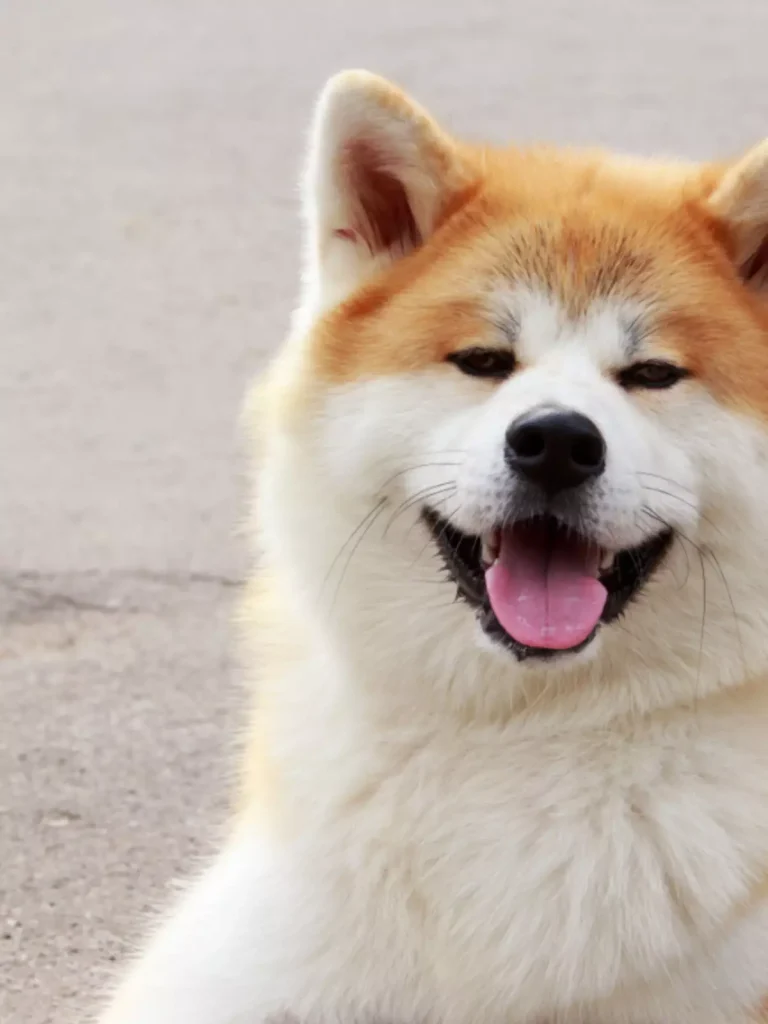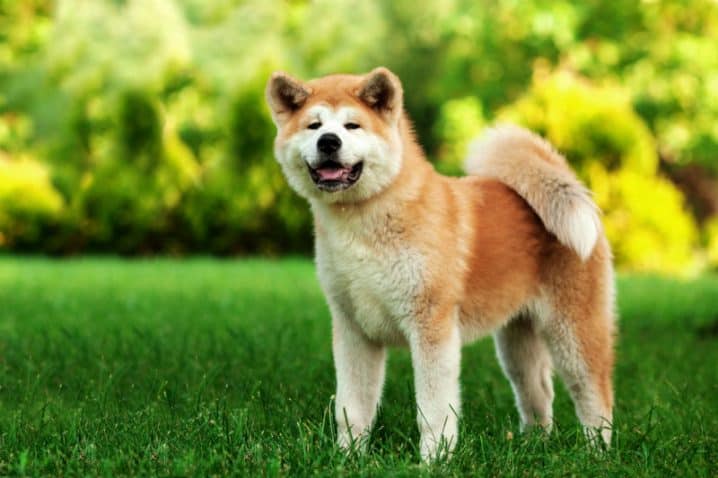
Originating from the mountainous island of Honshu, Japan, the Akita is known for its powerful impression and intelligence.
This breed was originally used as a guard dog for the Japanese royalty and nobility during the feudal era. Its remarkable loyalty and courage make it an excellent guardian for your home.
The Akita can grow as tall as 28 inches and can weigh as much as 130 pounds. Hot or cold weather is not a problem for it. As a member of the Spitz family, it boasts a double coat which helps regulate its body temperature and repel dirt and moisture.
Contents
One-Time Expenses
The Akita is listed as the tenth most expensive purebred dog so it’s not really the budget-friendly type. The Akita price is affected primarily by the location and number of breeders in an area.
Puppies can be bought cheaply from the Greenfield Puppies with just a budget of $600 to $2,000.
Some people sell puppies or adults for only around $600 to $5,000 and you can check them on the Puppy Finder website. There are also a lot of other sites that you can search and buy from such as the Lancaster Puppies and Next Day Pets.
The Akita Club of America also has a breeder locator listing that you may find useful for finding information regarding local breeders.
Getting one does not necessarily mean buying one. If you are a bit low on the budget or just prefer adopting rather than buying, there are a lot of animal shelters/rescue centers and adoption sites where you can get an Akita.
One of the best adoption sites is the Akita Rescue Mid-Atlantic Coast (ARMAC). It helps educate and provide support not only for those who adopt from it but for all Akita owners. It mainly saves Akita adults in animal shelters from being euthanized.
You can also check other adoption websites such as the Adopt a Pet, TikiHut Akita Rescue Association (TARA), The Akita Rescue Society of Florida (ARSF) and the Passion for Paws.
Aside from the initial cost of buying a puppy or adult Akita, upfront costs also involve expenses on accessories and shelter for the dog. The primary ones are the food and water bowls, bedding, crate, and leash and collar.
- Food and Water bowls
Some pet stores already include food and water bowls when buying. But if not, there are a lot of online or local pet stores that you can buy from. Recommended high-quality food and water bowls can be bought from PetSmart for only $5 to $50.
- Crate
An Akita can grow up to 28 inches on average. Dogs this size require at least an L-size (40” x 28” x 30”) crate. You can buy a good quality one from Petco with a budget of $50 to $280.
- Bedding
Similarly, large-sized beddings (30” x 40”) are recommended for your Akita to make it feel more comfortable given its big body size. Large-sized beddings can also be found at Petco and are priced around $30 to $100.
- Leash and collar
The Akita does not necessarily need intense exercises. Regular exercises are enough for it to stay physically healthy and it can do with just a regular good quality leash and collar. You can choose from a variety of designs on ForDogTrainers.com for $25 to $80.
What are Included When Buying an Akita?
Buying an Akita includes the usual documents when buying a dog from a reputable breeder. These are the registration certificate, pedigree, and health papers. A complete set of documents serves as a guarantee that the breeder is a competent one.
The registration certificate contains the details regarding the origin of the dog (e.g. father, mother, birthdate). The pedigree is basically the document that shows the dog’s family tree; while the health papers indicate whether the breed is prone to any hereditary health problem (this is very important for the Akita since it is prone to several hereditary health problems).
There are some stores such as the Greenfield Puppies that include a 30-day health guarantee from the breeders. They also have their puppies usually dewormed and vaccinated and checked recently by a veterinarian.
Also, Akita puppies/adults adopted from the ARMAC are readily spayed/neutered, microchipped, vaccinated, and properly evaluated in terms of behavior.

What are the Recurring Expenses?
Aside from the initial upfront costs, a responsible owner needs to spend a good amount of money to maintain a healthy Akita. Being one of the most expensive breeds in terms of buying price, it is also a bit expensive to care for.
A good thing about the Akita is that it is pretty much low-maintenance in terms of behavior. The only laborious part of owning one is when taking care of its hair. It only requires moderate but consistent exercise with regards to maintaining its physical health.
The usual recurring expenses involve costs on foods, toys, and health care, as discussed below:
Food – dog foods rich in animal-based proteins are recommended for the Akita. Some of the recommended high-quality dog foods are the following:
- Fromm Four Star Duck and Sweet Potato Dry Dog Food which costs around $60 per 30 pounds;
- ACANA Adult Large Breed Formula that costs $70 per 11.4 kilograms (25.08 pounds);
- Blue Buffalo Wilderness Large Breed Adult Salmon Recipe priced at $55.99 per 24 pounds.
You may also ask professionals for other brands of dog food they may specifically recommend for your pet Akita.
Toys – the Akita does not really need a lot of toys for training. The only toys it really needs are those for moderate exercising and casual playing. Ball and chew toys are the recommended types.
You can buy them from PetMountain.com. It has a very large selection of toys with prices as low as $2 and up to $80.
Healthcare – this is the most important part of caring for your pet; but it is also the most expensive. Health care costs are mostly from expenses on spaying/neutering, vaccinations, and hair and dental care. Being double-coated, the Akita is also more prone to skin problems.
Spay and neuter cost more for heavier dogs and are more expensive for females. Spay Spa and Neuter Nook offers spay and neuter services from $100 to $200. Anicira also offers the same services but for a higher price of $149 to $219. It also offers vaccinations and microchipping when availing of its spay/neuter service.
Similarly, the Jessica Beath Clinic offers cheaper services for only $50 to $60. Owners can also avail of its vaccine and microchip services for only $10 each.
The Akita are one of those breeds that may have reactions to vaccinations so make sure that you go to a trusted clinic before subjecting your pet to one. The Abrams Forest Veterinary Clinic offers low-cost vaccinations ranging only from $10 to $50 depending on the type of vaccine. It also offers dental services for as low as $150 although it admits that they are of mediocre quality due to their relatively cheaper price.
You can also buy dog treats that can help improve your Akita’s dental health such as the Pedigree Dog Treats Dentastix priced at $15.47 per 1.57 pounds.
The Rudy’s Feed Store also offers affordable vaccination services with prices ranging from $11 to $24 depending on the vaccine and it conducts microchipping for $38.
Since the Akita is a heavy shedder, it needs more attention regarding its coat. One recommended brush to maintain the Akita’s smooth double coat is the Professional Slicker Brush which costs $10.95.
The Oster Wide Coarse Rake can also be used to easily remove dead undercoat. You can buy one from Chewy for only $21.64.
Shampoos are very useful in grooming the Akita. They help maintain its soft double coat while also lessening the shedding. The Groomer’s Edge Oat Mella Shampoo costs only $8.95 per 16 oz. and is perfect for double coat breeds.
If you are worried about possibly irritating its eyes when bathing it, you can buy the Isle of Dogs Tearless Shampoo for only $12.99.
What are the Things to Consider Before Buying One?
First, the cost. The cost does not only mean the initial upfront costs, but also the upkeep costs. Buying an Akita is more expensive compared to other breeds, and maintaining one is more expensive in the long run.
Second, the environment. Compared to other breeds, the Akita can easily adjust to its environment and is not that choosy. As long as there is adequate space in the household, it can make itself comfortable. It is not a picky breed and can be easily house-trained.
The Akita is very friendly. It goes well with children and other pet animals easily as long as it is exposed to socializing from an early age.
Another important thing is that it sheds heavily. This may be problematic for households with children but is easily preventable with proper care.
It is also not known to bark much, making it a suitable pet for those who live in an apartment setting. This does not mean that it is not good for guarding. Instead, it actually is better since if your pet Akita barks, it means something is worthy of your attention.
Third, possible health conditions. Owners looking to get an Akita should be aware of the possible hereditary health problems the breed may inherit. These are hip dysplasia, Gastric Dilatation-Volvulus (GDV), Entropion, and other nervous and auto-immune diseases. The owners should make sure that the Akita they want underwent proper screening.
Tips and Facts About the Akita
There are two known variants of the Akita: the Japanese Akita (Akita Inu) and the American Akita (Akita). Most places and organization consider these two variants of Akita as two separate breeds, except for the American Kennel Club and the Canadian Kennel Club.
There is not much difference between the two except minor physical dissimilarities. The American Akita has more variety of colors compared to the Japanese Akita. The American Akita is also a bit larger than the Japanese Akita, with 2 to 3 inches difference in height and 5 to 10 pounds difference in weight on the average.
The most significant difference between the two is their facial structure. The American Akita has a broader head while the Japanese Akita has a more fox-like head shape.
The Akita has a dense double coat – it has a thick, plush, and wooly undercoat, and a short and smooth overcoat (guard hairs). Having a double-coat means the Akita has a longer hair and smoother texture. But this also means that it is more prone to skin irritation and allergies.
A general advice would be to never shave the Akita except during extreme medical conditions. This can help to avoid the aforementioned tendencies of a double-coat, but also because it may not be able to grow its hair back like before.
It is advisable to brush it weekly to keep its coat healthy and at the same time lessen the amount of loose hair. Practice the Akita by brushing it; starting at an early age. It will be used to brushing early and will learn to behave properly as it grows old.
The Akita is the type of dog who would rather live inside the house with its family. It may enjoy playing in a large yard, but it is happier when kept inside during free time instead of being left outside alone.
Lastly, don’t hesitate to ask other Akita owners for information and tips. Technology now makes it easier to connect with other people through websites or online forums. Just don’t forget to consult an actual professional for serious health and behavioral concerns.
